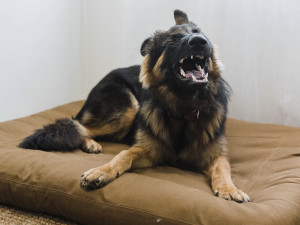Bulldogs and Other Flat-Faced Breeds Are Being Banned. Here’s Why
Breeds with those squished-in faces are charming — but their health issues are not.

Share Article
Those smooshy faces. Those big round eyes. There’s just something about breeds like Pugs, French Bulldogs, and Shih Tzus that draws people in. But recently, some of these flat-faced dogs (known as brachycephalic breeds) have drawn the attention of animal welfare advocates.
In fact, earlier this year, concerns about health issues led courts in Norway to banopens in new tab the breeding of Bulldogs and Cavalier King Charles Spaniels, calling it a violation of the Norwegian Animal Welfare Actopens in new tab. Similar bans on some brachycephalic breeds are being considered in the U.Kopens in new tab. Veterinary associations in Canadaopens in new tab and Australiaopens in new tab have called for more selectivity when breeding brachycephalic dogs and more pet owner education around potential health risks.
In other words, this is a topic you’ll likely hear about in the news more and more. Here’s what this is all about.
Health Risks for Brachycephalic Breeds
“Brachycephalic” is a term used to describe dogs (or cats) that have flat faces and short muzzles. And with those adorable features come potential health issues, such as Brachycephalic Airway Syndromeopens in new tab. Dr. Jamie Freyer, a veterinarian and Manager of Data and Veterinary Genetics at Wisdom Health, describes that condition.

“Dogs with brachycephalic syndrome have really small nostrils and a really long soft palate that hangs back and obstructs the airways,” Dr. Freyer says. “So, they are breathing in air through a small opening, and then when the breath gets to the back of their throat, it reaches another obstacle, which makes breathing in general hard. And that difficulty breathing can, in part, lead to concerns around heat stroke, heart problems, and other issues.”
Some other challengesopens in new tab these breeds may face include eye abnormalities, spinal malformations, ear infections, skin infections, dental problems, and difficulty exercising, sleeping, and eating.
What Prompted the Push for Change?
People have been breeding dogs for certain traits for centuries. Sometimes, these choices are made to make a breed better suited for a specific job. Other times, they are based on aesthetic preferences. And breed standards, which leave room for a breeder’s interpretation, do evolve over time.
“If you look online at old pictures of a Bulldog, for example, you can see how the breed’s appearance has changed,” says Dr. Freyer. “Their heads have gotten bigger. That makes natural birth complicated, so they are generally only delivered by C-section. And they’ve been bred to have a lot of skin folds, which people think are cute but don’t always realize they require frequent cleaning to prevent skin infections.”
Regardless of how these dogs arrived at their current state, flat-faced breeds have been around for a long time. Why are some countries taking action now? In all likelihood, it’s due to the sky-rocketing popularity of these breeds. As the number of brachycephalic dogs grows, so does the prevalence of associated health risks.
So, is the way to address these concerns really to eliminate some of the world’s most recognizable dog breeds? Not necessarily. Ashild Roaldset, CEO of the Norwegian Society for the Protection of Animals (the group opens in new tab that brought forth the court case that led to the ban in Norway), says the end goal is to have more conversations about how to make these breeds healthier.
In the meantime, it’s important for pet parents considering a brachycephalic breed to make that choice with their eyes wide open.
Considerations for Pet Parents
People thinking about getting a brachycephalic breed may not understand the full range of potential challenges. To be fair, the severity of conditions can range, and not all dogs within these breeds have severe conditions. Still, having a flat-faced breed as part of your family can impact everything from your budget to the climate you live in to the activities you do with your pup.
“In my experience seeing brachycephalic patients, a lot of pet parents are unaware of the number of health issues these breeds can have and are surprised by the expense and time needed to care for them,” says Dr. Freyer.
Nikki Carvey, founder and president of Roadogs & Rescueopens in new tab, backs up that statement. As the leader of an organization dedicated to rescuing and rehabbing Bulldogs with medical problems and puppies born with disabilities, she has a lot of firsthand insight.
“One of the most common reasons people surrender a dog is because they can’t afford the medical care,” says Carvey. “Sometimes, we get calls from owners when they are at the emergency vet, and their dog needs to be hospitalized for pneumonia or a life-saving surgery. When it comes to puppies with a disability, we usually get asked to take them because they can be more complicated to care for and people just do not have the time —or the commitment.”
Carvey addes that Bulldogs are not an affordable dog to care for: “They are not a breed for someone on a budget. Sadly, many people get sucked in by the cute factor, pay a lot of money to get one, and then have no money to pay for quality veterinary care.”
So, what’s some advice for prospective pet parents as these breeds and their legality continue to make news? “If you’re thinking about getting a certain breed — any breed — it’s really important to do your research,” says Dr. Freyer. “Prepare yourself for potential health problems and understand what you’re getting into as it relates to the breed’s day-to-day care.”
And always, consider adopting over buying from a breeder.

Kate Sheofsky
Kate Sheofsky hails from San Francisco, where she developed a love of writing, Giants baseball, and houses she can’t afford. She currently lives in Portland, OR, and works as a freelance writer and content strategist. When not typing away on her laptop, she enjoys tooling around the city with her two rescue pups searching for tasty food and sunny patios.
Related articles
Reverse Sneezing or Honking Noise in Dogs: Causes and Treatment
Don’t panic: It’s called reverse sneezing, and in most cases, it’s nothing to worry about.
![Woman in athletic clothing jogging up stairs in a tropical city with her two dogs on leashes running with her]()
Running With Your Dog Is Possible — It Doesn’t Just Happen in Photoshoots
You — yes you! — can be one of those fun people who runs with your dog. Just be smart about it.
![Dog laying down in dog bed and coughing]()
Why Is My Dog Coughing?
Seven reasons to be concerned when your dog is coughing.




